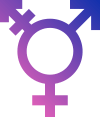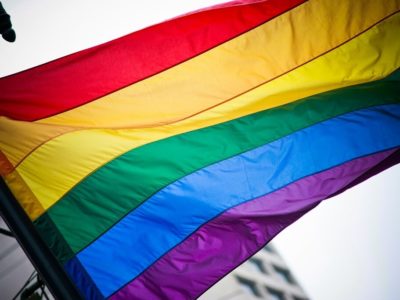History can be defined through periods of civil rights movements: women, African-American, and now—the gay rights movement. As Millennials, fighting for LGBT equality is our movement.
It’s happening right now, and we’re the activists working toward change. Students at Davidson College hung gay pride flags from their dorm windows to support a gay student who was banned from doing the same. Dartmouth students protested outside the office of the university's president, demanding a response to concerns, which included the campus climate for the LGBT community. A graduate student at the University of Mississippi took a stand for equality by creating a Facebok page and helping distribute stickers at a protest during the college's graduation.
The only way to make sure change like these continue to happen is to stay informed.
If you’re just getting into LGBT issues, you may feel confused, especially with the sea of new terms. What do all the letters represent? What’s the difference between transgender and transsexual? What does pansexual even mean?
The LGBT community uses dozens of terms, many of which you might have never heard. So, before we can start a discourse about LGBT issues and work toward that change, it’s important that we have a solid foundation.
Consider this article “LGBT 101.” You might be new to the LGBT community and want to learn more. Maybe you have a friend who just came out and you want to know the proper vocabulary. Perhaps you want to educate yourself so you can better fight for LGBT equality on your college campus. Either way, here’s a handy cheat sheet to help you stay informed.
LGBT 101
LGBT– This stands for lesbian, gay, bisexual and transgender. The acronym is used to refer to those individuals who make up the “gay” community. The acronym is sometimes extended to LGBTQA+. The “Q” stands for queer or questioning, the “A” for ally or asexual, and the plus sign for any other identities that fall along the spectrum.

Spectrum– This is a term that can apply to both gender and sexuality. Rather than have rigid “boxes” that people fit into (i.e. male, female, straight, gay), gender and sexuality exist on a spectrum that includes many different gender identities and sexual orientations.
Sexual orientation– This is a term used to describe and classify an individual’s sexual attractions. Sexual orientations should be viewed as terms for self-identification and should never be imposed on an individual.
- Heterosexual/Straight– People who identify as heterosexual, or straight, experience attraction to members of the opposite gender.
- Homosexual/Gay/Lesbian– People who identify as homosexual experience attraction to members of the same gender. “Homosexual” started as a medical term and may now have a negative connotation depending on the individual. “Lesbian” and “gay” are typically more accepted terms.
- Bisexual– People who identify as bisexual experience attraction to both members of the opposite gender and the same gender.
- Pansexual– People who identify as pansexual experience sexual attraction toward people of all gender identities, regardless of where they may fall on the spectrum. This is different from bisexual, which is classified as attraction to the two binary genders, male and female.
- Asexual– People who identify as asexual do not experience sexual attraction.
- Queer– This is an umbrella term that people may use if they do not conform to societal norms for gender and sexuality.
Biological sex/assigned sex– Sex refers to the physiological and anatomical characteristics that classify individuals as male or female. At birth, individuals are assigned a sex based on these characteristics, which primarily include genitalia.

Gender– Gender is similar to, but not the same as, sex. While sex is primarily a medical and anatomical term, gender is a social identity constructed to help organize and classify individuals. Typically, but not always, a person’s gender will be the same as his or her sex.
- Gender identity– This is how people classify themselves in terms of gender. For example, you might assume someone’s gender as male, but they might identify with the female gender.
- Gender expression– This is made up of actions, mannerisms and numerous characteristics that are meant to convey one’s gender identity. For example, having long hair, applying makeup and wearing a dress might be characteristics of a stereotypical “female” gender. Different forms of expression might be demonstrated by clothes, speech or activities.
- Cisgender– This means that you identify with the sex and gender assigned to you at birth. Individuals who are cisgender are not transgender and typically are “gender-normative.”
- Genderqueer– This is an identity that some people claim for themselves if they lie somewhere on the spectrum that is not strictly “male” or “female.”
Transgender/transsexual– This is a term used to describe an individual who is not cisgender, meaning the person does not identify with the sex assigned at birth. Transgender is more of an umbrella term for those who break gender norms, meaning it may include cross dressers and drag queens. Transsexual is a medical term used to describe individuals who feel their body does not match their gender identity.
- MtF/M2F/Male to Female– This is a term used to describe the direction of an individual’s transition from male to female. This individual may also be referred to as a trans woman.
- FtM/F2M/Female to Male– This is a term used to describe the direction of an individual’s transition from female to male. This individual may also be referred to as a trans man.
- Passing– This is a term used in the transgender community to indicate that a person is “passing” for a cisgender individual. For example, a trans man would be passing if he were identified by society as a male.
- Transition– This is the process of changing gender or sex and can have different parts, including a social transition, as well as a medical transition. A social transition might involve changing names or clothing, while a medical transition includes surgery and hormones.

Intersex– This is a medical diagnosis that is assigned to an individual whose anatomy is different from that of the typical “male” or “female” in terms of genitalia.
Gender binary– This is a term used to describe the belief that there are only two genders—male and female.
Preferred pronouns– This is a term used to describe the pronouns by which an individual would like to be referred. Typical pronouns are the male “he, him, his,” the female “she, her, hers,” and the gender neutral “they, them, theirs,” but there are other gender neutral pronouns such as “ze” and “hir.”
Ally– Allies are straight supporters of the LGBT community.
Learning the vocabulary is a great first step to getting involved in the LGBT community. Now that you know the proper terms, put it to good use by fighting for change on your college campus. Maybe that means you petition for gender-neutral bathrooms. Maybe you start smaller and provide support for LGBT students or your university’s gay-straight alliance. No effort is too small—even if all you do at first is learn the right words to say.
Image from Flickr user Charlie Nguyen used under Creative Commons.



















